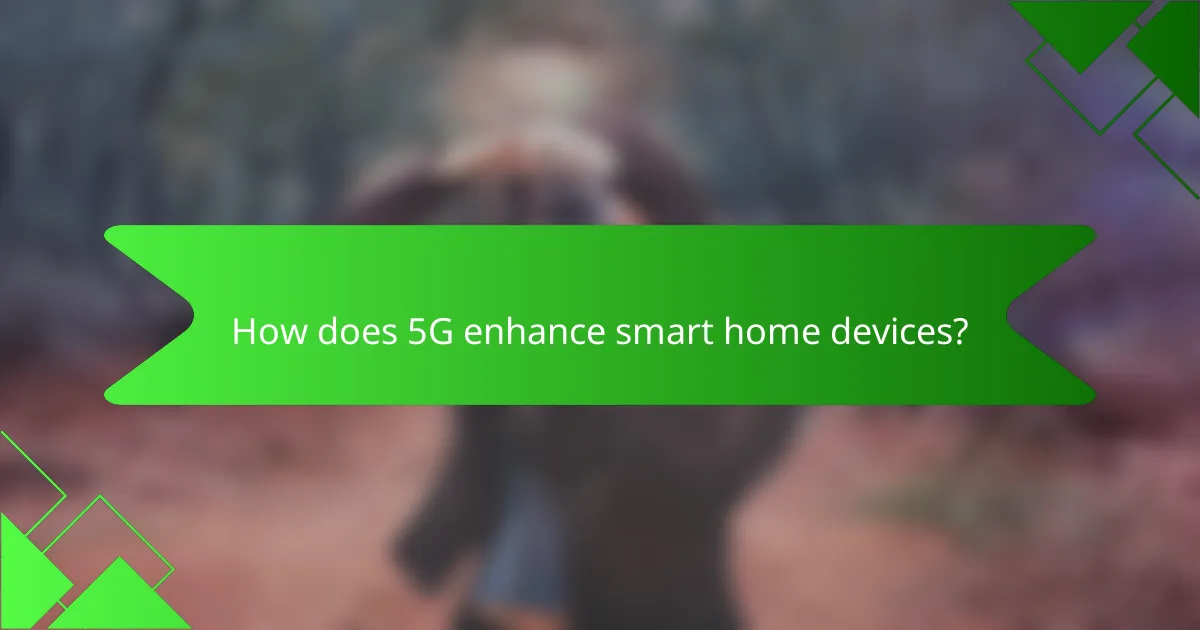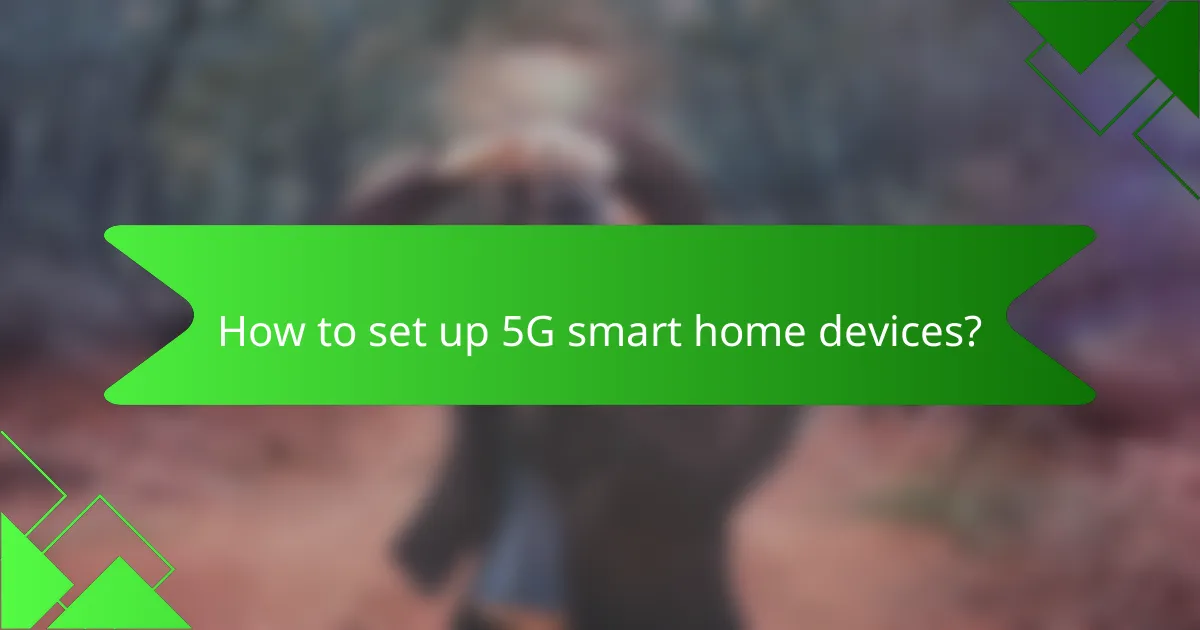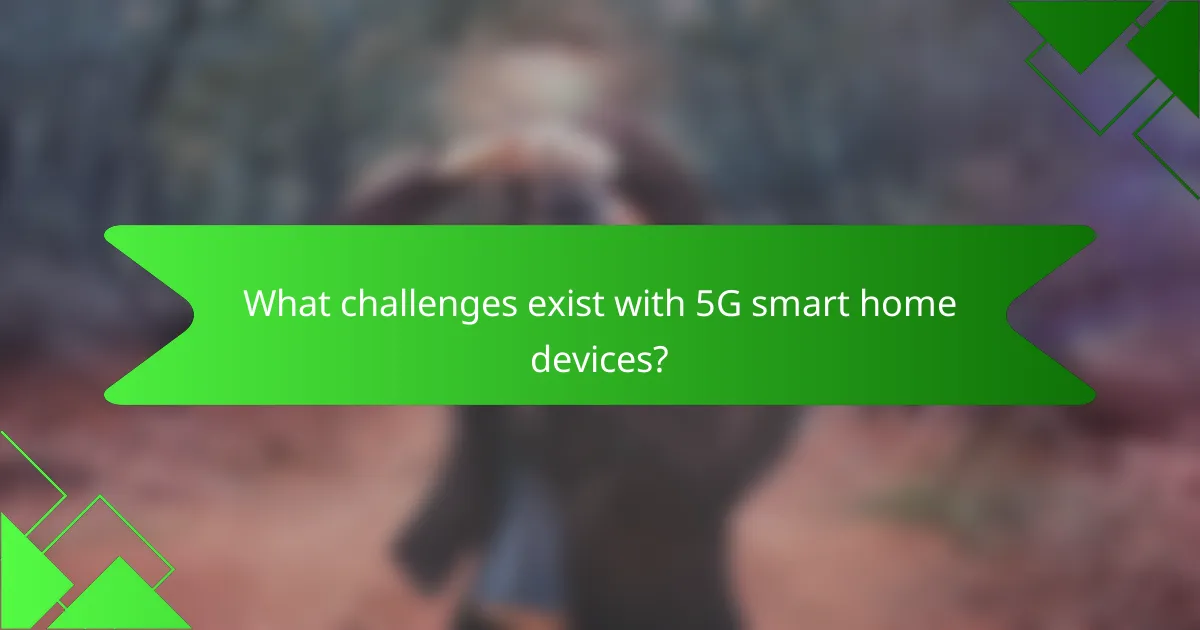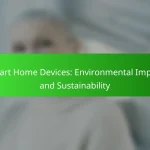5G technology is revolutionizing smart home devices by delivering faster data transfer rates and improved connectivity, which enhances the performance of various applications. With lower latency and higher bandwidth, these devices can operate more seamlessly and reliably, transforming the way we interact with our homes. Setting up 5G-enabled smart devices ensures optimal efficiency and a superior user experience, making smart living more accessible than ever.

How does 5G enhance smart home devices?
5G technology significantly enhances smart home devices by providing faster data transfer rates, improved connectivity, and lower latency. These advancements enable a more seamless and efficient operation of various smart home applications, making them more responsive and reliable.
Faster data transfer rates
5G networks offer data transfer speeds that can be several times faster than previous generations, often exceeding 1 Gbps. This increase allows smart home devices to communicate and process information rapidly, enabling features like high-definition video streaming and real-time monitoring without lag.
For example, a smart security camera can transmit high-quality video feeds instantly, allowing homeowners to view live footage from anywhere. This speed is particularly beneficial for applications that require large amounts of data, such as virtual reality or augmented reality experiences in the home.
Improved device connectivity
5G technology supports a significantly higher number of connected devices per square kilometer compared to 4G, facilitating the integration of multiple smart home devices. This means that households can operate numerous devices simultaneously without experiencing connectivity issues.
With 5G, devices like smart thermostats, lights, and appliances can communicate more effectively, leading to better automation and control. For instance, a smart home hub can manage various devices at once, optimizing energy usage and enhancing user convenience.
Lower latency for real-time applications
5G networks are designed to have lower latency, often around 1 millisecond, which is crucial for real-time applications. This reduction in delay allows smart home devices to respond almost instantaneously to user commands or automated triggers.
For example, a smart doorbell can alert homeowners in real-time when someone is at the door, allowing for immediate interaction. This low latency is essential for applications like remote healthcare monitoring, where timely data transmission can impact health outcomes.

What are the best smart home devices with 5G support?
The best smart home devices with 5G support enhance connectivity, speed, and reliability, allowing for seamless integration of various smart technologies. These devices leverage the high bandwidth and low latency of 5G networks to improve performance and user experience.
Samsung SmartThings Hub
The Samsung SmartThings Hub is a central device that connects and manages various smart home devices. With 5G support, it can facilitate faster communication between devices, enabling real-time responses and automation.
When setting up the SmartThings Hub, ensure that it is compatible with your existing devices. It supports a wide range of protocols, including Zigbee and Z-Wave, making it versatile for different smart home ecosystems.
Google Nest Hub Max
The Google Nest Hub Max combines a smart display with 5G connectivity, allowing for high-quality video streaming and video calls. Its integration with Google Assistant enables voice control over other smart devices, enhancing convenience.
Consider using the Nest Hub Max for home security features, such as monitoring live feeds from compatible cameras. The 5G support ensures that these functionalities operate smoothly without lag, providing peace of mind.
Amazon Echo Show 10
The Amazon Echo Show 10 is a smart display that rotates to follow you, making it ideal for video calls and watching content. With 5G connectivity, it offers faster access to Alexa services and smart home controls.
When using the Echo Show 10, take advantage of its ability to integrate with a variety of smart home devices. The 5G support allows for quicker responses and improved functionality, especially in larger homes with multiple devices connected.

How to set up 5G smart home devices?
Setting up 5G smart home devices involves selecting the right router, connecting your devices to the network, and configuring their settings. This process ensures that your smart home operates efficiently and takes full advantage of the high-speed connectivity that 5G offers.
Step 1: Choose a compatible router
To start, select a router that supports 5G connectivity and is compatible with your smart devices. Look for routers that comply with the latest Wi-Fi standards, such as Wi-Fi 6, which can enhance performance and coverage.
Consider the size of your home and the number of devices you plan to connect. A dual-band router may suffice for smaller spaces, while larger homes might benefit from a mesh network system to ensure consistent coverage throughout.
Step 2: Connect devices to the network
Once you have your router set up, connect your smart home devices to the 5G network. This typically involves using the device’s app or interface to find and select your network, then entering the password.
For optimal performance, ensure that your devices are within a reasonable range of the router. If you experience connectivity issues, consider relocating devices closer to the router or using Wi-Fi extenders to boost the signal.
Step 3: Configure device settings
After connecting your devices, configure their settings to maximize functionality. This may include setting up routines, adjusting notifications, and linking devices to a central smart home hub if applicable.
Regularly check for firmware updates for your devices and router to ensure they operate smoothly and securely. Additionally, familiarize yourself with any privacy settings to protect your data while using these connected devices.

What are the benefits of 5G for smart homes?
5G technology offers significant advantages for smart homes, including faster data transfer, lower latency, and improved connectivity for multiple devices. These benefits enhance the overall functionality and efficiency of smart home systems, making them more responsive and reliable.
Enhanced security features
5G enables advanced security features for smart homes by supporting more robust encryption and real-time monitoring. With faster data transmission, security cameras and sensors can communicate instantly, allowing for quicker responses to potential threats.
Homeowners can benefit from features such as facial recognition and motion detection that operate seamlessly over 5G networks. This technology can help reduce false alarms and improve the accuracy of security alerts.
Energy efficiency improvements
5G connectivity can lead to significant energy efficiency improvements in smart homes by optimizing device performance and reducing energy consumption. Smart appliances can communicate more effectively, allowing them to operate during off-peak hours or when energy rates are lower.
For instance, smart thermostats can adjust heating and cooling based on real-time data, potentially reducing energy bills by a noticeable percentage. Homeowners can also monitor their energy usage more accurately, leading to better management of resources.
Scalability for future devices
5G technology offers scalability for smart homes, allowing homeowners to easily add new devices without compromising performance. The increased bandwidth and capacity of 5G networks can support a larger number of connected devices simultaneously.
This means that as new smart home technologies emerge, such as advanced lighting systems or smart appliances, homeowners can integrate them seamlessly into their existing setups. Planning for future upgrades becomes simpler, ensuring that the smart home remains up-to-date and efficient.

What challenges exist with 5G smart home devices?
5G smart home devices face several challenges that can hinder their widespread adoption and functionality. Key issues include coverage limitations in rural areas, higher costs for 5G hardware, and potential compatibility problems with existing devices.
Coverage limitations in rural areas
5G networks are primarily concentrated in urban and suburban regions, leaving many rural areas with limited or no access. This lack of coverage can prevent users in these locations from fully utilizing 5G smart home devices, which rely on high-speed internet connectivity.
In rural settings, users may need to consider alternative solutions, such as satellite internet or 4G LTE, which may not offer the same performance as 5G. It’s essential to check local service availability before investing in 5G devices.
Higher costs for 5G hardware
The initial investment for 5G smart home devices can be significantly higher compared to their 4G counterparts. This includes not only the devices themselves but also the necessary infrastructure upgrades, such as routers and modems that support 5G technology.
Consumers should weigh the benefits of faster speeds and lower latency against the higher costs. It may be beneficial to look for bundled offers from service providers that can help mitigate these expenses.
Potential compatibility issues
As 5G technology is still evolving, compatibility issues may arise with existing smart home devices that were designed for older networks. Some devices may require firmware updates or may not function optimally on a 5G network.
Before purchasing new 5G devices, check for compatibility with your current smart home ecosystem. Additionally, consider the longevity of your existing devices to avoid premature obsolescence.










